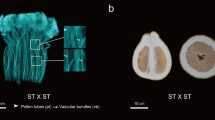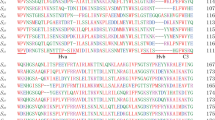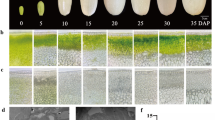Abstract
Key message
CaPCR1 (Capana12g002165) was a candidate gene regulating fruit concave/pointed tip shape in pepper.
Abstract
The concave shape of the fruit tip in pepper plants is highly susceptible to drought and low temperature stresses, resulting in the appearance of a pointed tip fruit, which affects its commercial value. However, few studies on the process of fruit tip development and regulatory genes in pepper have been reported. Herein, the developmental process of the ovary before anthesis, especially changes in the shape of the ovary tip, was studied in detail. The results showed that the final fruit tip shape was consistent with the ovary tip shape before anthesis, and a concave tip shape gradually developed. F4 recombinant inbred lines (RILs) were constructed to map the genes regulating fruit tip shape through hybridization of the LRS and SBS pepper inbred lines. CaPCR1 (Capana12g002165), an OFP (OVATE Family Protein) family gene, was located in the candidate region on chr12. Three SNPs were found in the protein coding sequence of CaPCR1 between SBS and LRS, but only one SNP led to amino acid variation. Sequence variations, including base replacements, deletions and insertions, were also detected in the gene promoter region. The relative expression level of the CaPCR1 gene was significantly greater in the concave tip ovary than in the pointed tip ovary. qRT‒PCR analysis revealed that the CaPCR1 gene was expressed mainly in the gynoecium, placenta and green fruit pericarp, which was consistent with its function in ovary and fruit development. Taken together, these results suggested that CaPCR1 is a candidate gene involved in fruit tip shape determination in pepper.






Similar content being viewed by others
Data availability
The data underlying this article are available in the article an in its online supplementary material.
References
Arnaud N, Lawrenson T, Ostergaard L, Sablowski R (2011) The same regulatory point mutation changed seed-dispersal structures in evolution and domestication. Curr Biol 21:1215–1219
Ashley S, Carmen K, Esther VDK (2020) The shape of things to come: ovate family proteins regulate plant organ shape. Curr Opin Plant Biol 53:98–105
Barten JHMD, Scott JW, Gardner RG (1994) Characterization of blossom-end morphology genes in to-mato and their usefulness in breeding for smooth blossom-end scars. J Am Soc Hortic Sci 119:798–803
Borovsky Y, Paran I (2011) Characterization of fs10.1, a major QTL controlling fruit elongation in Capsicum. Theor Appl Genet 123:657–665
Borovsky Y, Raz A, Doron-Faigenboim A, Zemach H, Karavani E, Paran I (2022) Pepper fruit elonga-tion is controlled by Capsicum annuum Ovate Family Protein 20. Front Plant Sci 12:815589
Cao Y, Zhang K, Yu H, Chen S, Xu D, Zhao H, Zhang Z, Yang Y, Gu X, Liu X, Wang H, **g Y, Mei Y, Wang X, Lefebvre V, Zhang W, ** Y, An D, Wang R, Bosland P, Li X, Paran I, Zhang B, Giuliano G, Wang L, Cheng F (2022) Pepper variome reveals the history and key loci associated with fruit domestication and diversification. Mol Plant 15:1744–1758
Chaim AB, Borovsky Y, Rao GU, Tanyolac B, Paran I (2003) fs3.1: a major fruit shape QTL conserved in Capsicum. Genome 46:1–9
Chunthawodtiporn J, Hill T, Stoffel K, Van Deynze A (2018) Quantitative trait loci controlling fruit size and other horticultural traits in bell pepper (Capsicum annuum). The Plant Genome 11:160125
Chusreeaeom K, Ariizumi T, Asamizu E, Okabe Y, Shirasawa K, Ezura H (2014) A novel tomato mu-tant, Solanum lycopersicum elongated fruit1 (Slelf1), exhibits an elongated fruit shape caused by increased cell layers in the proximal region of the ovary. Mol Genet Genom 289:399–409
Colle M, Weng Y, Kang Y, Ophir R, Sherman A, Grumet R (2017) Variation in cucumber (Cucumis sativus L.) fruit size and shape results from multiple components acting pre-anthesis and post-pollination. Planta 246:641–658
Colonna V, D’Agostino N, Garrison E, Albrechtsen A, Meisner J, Facchiano A, Cardi T, Tripodi P (2019) Genomic diversity and novel genome-wide association with fruit morphology in Capsicum, from 746k polymorphic sites. Sci Rep 9:10067
Cong B, Barrero LS, Tanksley SD (2008) Regulatory change in YABBY-like transcription factor led to evolution of extreme fruit size during tomato domestication. Nat Genet 40:800–804
Dong Y, Jantzen F, Stacey N, Łangowski A, Moubayidin L, Šimura J, Ljung K, Østergaard L (2019) Regulatory diversification of INDEHISCENT in the Capsella genus directs variation in fruit morphology. Curr Biol 29:1038–1046
Dou J, Zhao S, Lu X, He N, Zhang L, Ali A, Kuang H, Liu W (2018) Genetic map** reveals a candi-date gene (ClFS1) for fruit shape in watermelon (Citrullus lanatus L.). Theor Appl Genet 131:947–958
Du H, Yang J, Chen B, Zhang X, Zhang J, Yang K, Geng S, Wen C (2019) Target sequencing reveals genetic diversity, population structure, core-SNP markers, and fruit shape-associated loci in pepper varieties. BMC Plant Biol 19:1–16
Eldridge T, Łangowski A, Stacey N, Jantzen F, Moubayidin L, Sicard A, Southam P, Kennaway R, Len-hard M, Coen ES, Østergaard L (2016) Fruit shape diversity in the Brassicaceae is generated by varying patterns of anisotropy. Development 143:3394–3406
Gong S, Huang G, Sun X, Qin L, Li Y, Zhou L, Li X (2014) Cotton KNL1, encoding a class II KNOX transcription factor, is involved in regulation of fiber development. J Exp Bot 65(15):4133–4147
Hackbusch J, Richter K, Muller J, Salamini F, Uhrig JF (2005) A central role of Arabidopsis thaliana ovate family proteins in networking and subcellular localization of 3-aa loop extension homeodomain proteins. P Natl Acad Sci USA 102:4908–4912
Hernández Pérez T, Gómez García MDR, Valverde ME, Paredes López O (2020) Capsicum annuum (hot pepper): an ancient Latin-American crop with outstanding bioactive compounds and nutraceu-tical potential. a review. Compr Rev Food Sci F 19:2972–2993
Hill TA, Chunthawodtiporn J, Ashrafi H, Stoffel K, Weir A, Van Deynze A (2017) Regions underlying population structure and the genomics of organ size determination in Capsicum annuum. Plant Genome 10(3):plantgenome2017-03
Konishi S, Izawa T, Lin SY, Ebana K, Fukuta Y, Sasaki T, Yano M (2006) An SNP caused loss of seed shattering during rice domestication. Science 312:1392–1396
Ku H, Doganlar S, Chen K, Tanksley S (1999) The genetic basis of pear-shaped tomato fruit. Theor Appl Genet 9:844–850
Langmead B, Trapnell C, Pop M, Salzberg SL (2009) Ultrafast and memory-efficient alignment of short DNA sequences to the human genome. Genom Biol 10:R25
Łangowski A, Stacey N, Østergaard L (2016) Diversification of fruit shape in the Brassicaceae family. Plant Reprod 29:149–163
Lazzaro MD, Wu S, Snouffer A, Wang Y, van der Knaap E (2018) Plant organ shapes are regulated by protein interactions and associations with microtubules. Front Plant Sci 9:1766
LiHandsaker HB, Wysoker A, Fennell T, Ruan J, Homer N, Marth G, Abecasis G, Durbin R (2009) 1000 genome project data processing subgroup The sequence alignment/map format and SAMtools. Bioinformatics 25(16):2078–2079
Liu J, Van Eck J, Cong B, Tanksley SD (2002) A new class of regulatory genes underlying the cause of pear-shaped tomato fruit. P Natl Acad Sci 99:13302–13306
Livak KJ, Schmittgen TD (2001) Analysis of relative gene expression data using real-time quantitative PCR and the 2(-Delta Delta C(T)) method. Methods 25:402–408
Luo Y, Yang S, Luo X, Li J, Li T, Tang X, Liu F, Zou X, Qin C (2022) Genome wide analysis of OFP gene family in pepper (Capsicum annuum L). Front Genet. 30(13):941954
Muños S, Ranc N, Botton E, Bérard A, Rolland S, Duffé P, Carretero Y, Le Paslier M, Delalande C, Bouzayen M, Brunel D, Causse M (2011) Increase in tomato locule number is controlled by two single-nucleotide polymorphisms located near WUSCHEL. Plant Physiol 156:2244–2254
Naegele RP, Mitchell J, Hausbeck MK (2016) Genetic diversity, population structure, and heritability of fruit traits in Capsicum annuum. PLoS ONE 11:e0156969
Pan Y, Wang Y, McGregor C, Liu S, Luan F, Gao M, Weng Y (2020) Genetic architecture of fruit size and shape variation in cucurbits: a comparative perspective. Thero Appl Genet 133:1–21
Paran I, van der Knaap E (2007) Genetic and molecular regulation of fruit and plant domestication traits in tomato and pepper. J Exp Bot 58:3841–3852
Porebski S, Bailey L, Baum B (1997) Modification of a CTAB DNAextraction protocol for plants containing high polysaccharide and polyphenol components. Plant Mol Biol Rep 15:8–15
Reyes-Chin-Wo S, Wang Z, Yang X, Kozik A, Arikit S, Song C, **a L et al (2017) Genome assembly with in vitro proximity ligation data and whole-genome triplication in lettuce. Nat Commun 8:14953
Rodríguez GR, Muños S, Anderson C, Sim S, Michel A, Causse M, Gardener BBM, Francis D, van der Knaap E (2011) Distribution of SUN, OVATE, LC, and FAS in the tomato germplasm and the rela-tionship to fruit shape diversity. Plant Physiol 156:275–285
Sandoval-Oliveros R, Guevara-Olvera L, Beltrán JP, Gómez-Mena C, Acosta-García G (2017) Developmental landmarks during floral ontogeny of jalapeño chili pepper (Capsicum annuum L.) and the effect of gibberellin on ovary growth. Plant Reprod 30:119–129
Schmitz AJ, Begcy K, Sarath G, Walia H (2015) Rice Ovate Family Protein 2 (OFP2) alters hormonal homeostasis and vasculature development. Plant Sci 241:177–188
Shu P, Li Z, Min D, Zhang X, Ai W, Li J, Zhou J, Li Z, Li F, Li X (2020) CRISPR/Cas9-dediated SlMYC2 mutagenesis adverse to tomato plant growth and MeJA-induced fruit resistance to Botrytis cinerea. J Agr Food Chem 68:5529–5538
Sierra-Orozco E, Shekasteband R, Illa-Berenguer E, Snouffer A, van der Knaap E, Lee TG, Hutton SF (2021) Identification and characterization of GLOBE, a major gene controlling fruit shape and im-pacting fruit size and marketability in tomato. Hortic Res 8(1):138
Song J, Shang L, Li C, Wang W, Wang X, Zhang C, Ai G, Ye J, Yang C, Li H, Hong Z, Larkin RM, Ye Z, Zhang J (2022) Variation in the fruit development gene POINTED TIP regulates protuberance of tomato fruit tip. Nat Commun 13(1):5940
Staedler YM, Masson D, Schonenberger J (2013) Plant tissues in 3D via x-ray tomography: simple con-trasting methods allow high resolution imaging. PLoS ONE 8:e75295
Sun L, Rodriguez GR, Clevenger JP, Illa-Berenguer E, Lin J, Blakeslee JJ, Liu W, Fei Z, Wijeratne A, Meulia T, van der Knaap E (2015) Candidate gene selection and detailed morphological evaluations offs8.1, a quantitative trait locus controlling tomato fruit shape. J Exp Bot 66:6471–6482
Tsaballa A, Pasentsis K, Darzentas N, Tsaftaris AS (2011) Multiple evidence for the role of an ovate like gene in determining fruit shape in pepper. BMC Plant Biol 11:46
Van der Knaap E, Østergaard L (2018) Sha** a fruit: developmental pathways that impact growth patterns. Semin Cell Dev Biol 79:27–36
Vasile MA, Luebert F, Jeiter J, Weigend M (2021) Fruit evolution in Hydrophyllaceae. Am J Bot 108:925–945
Vuolo F, Mentink RA, Hajheidari M, Bailey CD, Filatov DA, Tsiantis M (2016) Coupled enhancer and coding sequence evolution of a homeobox gene shaped leaf diversity. Gene Dev 30:2370–2375
Wang S, Chang Y, Ellis B (2016) Overview of OVATE FAMILY PROTEINS, a novel class of plant-specific growth regulators. Front Plant Sci 7:187645
Wang Y, Clevenger JP, Illa-Berenguer E, Meulia T, van der Knaap E, Sun L (2019) A comparison of sun, ovate, fs8.1 and auxin application on tomato fruit shape and gene expression. Plant Cell Physiol 60:1067–1081
Wu S, Zhang B, Keyhaninejad N, Rodríguez GR, Kim HJ, Chakrabarti M, Illa-Berenguer E, Taitano NK, Gonzalo MJ, Díaz A, Pan Y, Leisner CP, Halterman D, Buell CR, Weng Y, Jansky SH, van Eck H, Willemsen J, Monforte AJ, Meulia T, van der Knaap E (2018) A common genetic mechanism underlies morphological diversity in fruits and other plant organs. Nat Commun 9(1):1–12
**ao H, Jiang N, Schaffner E, Stockinger EJ, van der Knaap E (2008) A retrotransposon mediated gene duplication underlies morphological variation of tomato fruit. Science 319:1527–1530
Xu J, Wang X, Guo W (2015) The cytochrome P450 superfamily: key players in plant development and defense. J Integr Agr 14:1673–1686
Zhang B, Li Q, Keyhaninejad N, Taitano N, Sapkota M, Snouffer A, van der Knaap E (2023) A combinatorial TRM-OFP module bilaterally fine-tunes tomato fruit shape. New Phytol 238:2393–2409
Zhao D, Li Q, Zhang C, Zhang C, Yang Q, Pan L, Ren X, Lu J, Gu M, Liu Q (2018) GS9 acts as a tran-scriptional activator to regulate rice grain shape and appearance quality. Nat Commun 9(1):1240
Zou Z, Zou X (2021) Geographical and ecological differences in pepper cultivation and consumption in China. Front Nutr 8:718517
Acknowledgements
This work was supported by the National Key Research and Development Program of China (2018YFD1000800) and National Natural Science Foundation of China (32172600). National Key Research and Development Program of China, 2018YFD1000800, Feng Li, National Natural Science Foundation of China, 32172600, Yingtian Deng
Funding
This study was supported by the National Key Research and Development Program of China (2018YFD1000800) and National Natural Science Foundation of China (32172600).
Author information
Authors and Affiliations
Contributions
F. L. and Y. D. conceived and designed the research; T. L. performed the research and wrote the first paper; Y. D, D. L. and S.G. conducted the experiments; Y. Z, J. W. and Z. L. analyzed the data; Y. D. participated in its design. All authors read and approved the manuscript.
Corresponding authors
Ethics declarations
Conflict of interest
The authors declare that they have no conflict of interest.
Additional information
Communicated by Esther van der Knaap.
Publisher's Note
Springer Nature remains neutral with regard to jurisdictional claims in published maps and institutional affiliations.
Supplementary Information
Below is the link to the electronic supplementary material.
Rights and permissions
Springer Nature or its licensor (e.g. a society or other partner) holds exclusive rights to this article under a publishing agreement with the author(s) or other rightsholder(s); author self-archiving of the accepted manuscript version of this article is solely governed by the terms of such publishing agreement and applicable law.
About this article
Cite this article
Liu, T., Dong, Y., Gao, S. et al. Identification of CaPCR1, an OFP gene likely involved in pointed versus concave fruit tip regulation in pepper (Capsicum annuum L.) using recombinant inbred lines. Theor Appl Genet 137, 161 (2024). https://doi.org/10.1007/s00122-024-04675-0
Received:
Accepted:
Published:
DOI: https://doi.org/10.1007/s00122-024-04675-0




